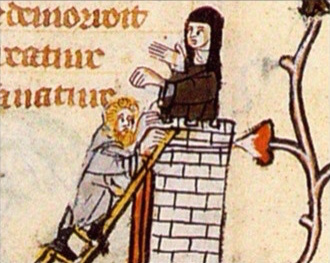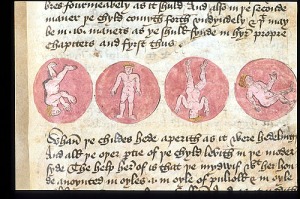
Hitomi Manaka as Lavinia, in Titus Andronicus (Ninagawa, 2006, RSC).
This post is closely based on part of a lecture – the second of a series – given at the University of Cambridge on 28/04/16. It includes, amongst other things, responses to the current British Library exhibition ‘Shakespeare in Ten Acts’. The lecture series was titled ‘Shakespeare: Performing the Unspeakable,’ and its two sub-parts were ‘Silence’ and ‘Suffering’.
Recently, I gave a couple of lectures on the ways in which Shakespeare’s plays – both in themselves, and as cultural artefacts – prompt us to think about the relationships between silence, suffering, and complicity. Shakespearean silence has a compelling performance history. In Shakespeare’s plays, the scripted silences – moments when, for example, the ghost of Hamlet’s father stalks away unspeaking from Horatio, or Cordelia refuses to elaborate on her brief response to her father – are many, and well known.
But there are, too, silences of a less certain kind. Silences that teeter on the brink between scripted and unscripted, that stretch out between the stage and the audience and last just long enough to cause a stir, an uneasy rustle of doubt.

Barbara Jefford and John Gielgud in Measure for Measure
One such example comes from Barbara Jefford’s performance of Isabella in Measure for Measure. In the script as we have it, Isabella – the virtuous novice who leaves her convent to petition for her brother’s life and attracts the romantic attention of the Duke – speaks for the last time several dozen lines before the end of the play.
In that time, the Duke twice proposes marriage to her, and twice receives no scripted answer. Some productions solve the problem – an eager nod, a horrified shake of the head – but Jefford, instead, froze in silence. She waited until the uneasy rustles and stirs of her audience communicated that their watching discomfort was too much – and only then did she speak. At the first performance, the silence reputedly lasted for around thirty seconds. As the production run continued, audiences collaborated: in their increasingly prolonged silences, they tacitly reinforced her decision to freeze out the spoken script and drown the duke’s proposal in a prolonged and shared speechless response.
Jefford’s silence allows the audience – supposedly passive – to collude with the character’s refusal to assent to a proposal of marriage that is phrased as a command. It sets into sharp prominence the assumptions about power and oppression that are latent in the text. The actress’s silence capitalizes on the permeable boundary between actor and audience, and it offers a succinct demonstration of the way in which plays – and characters, and characters’ responses – become rooted in time, snagged into the contemporary debates by hooks and links and tensions we can barely recognise, but whole constraining and constructing effect we still must feel.

Ira Aldridge in the role of Othello. James Northcote, c. 1826.
This was the tension negotiated by Ira Aldridge, often described as the ‘first’ black actor to play Shakespeare’s Othello. Born in 1807 in New York, Aldridge worked for much of his career in Britain. Audiences of the time romanticised Aldridge – indeed, he and the companies with whom he acted encouraged this romanticisation – picturing him not as the son of freed slaves and born in New York, but as a mysterious and noble African, estranged from his natal land and bearing evocative hints of a hidden story to tell. Perhaps shrewdly, Aldridge claimed descent from the Fulani people – even then, a group (or groups) dispersed over a wide area and representing people born in several different African countries – and this deliberate exoticism was balanced by posters representing him as an ‘African Roscius,’ a name that alluded to the Roman actor and freed slave, whose name was a byword amongst Shakespeare’s own contemporaries for Classical excellence in acting.
Aldridge’s presence tacitly argued that a black actor could – and did – embody and communicate the emotions Shakespeare had written for is characters, the identity that this white dramatist had constructed for a white performer. He made visible the argument – polemical at that time and in that place – that a black man could embody all the emotions of white humanity. Amidst this was a tacit – and occasionally, explicit – division within Aldridge’s audiences, between those who saw his acting as propaganda to stoke contemporary arguments against the slave trade, and those who had vested interests – based on that same trade – in castigating a black man who dared to see himself as a talented actor interpreting the most canonical works of a white dramatist. For Aldridge did not only play Othello. He also – in whiteface – took on the roles Shylock, Macbeth, Richard III and Lear, and even Iago: famous roles that have been closed to black actors until very recently, and which still draw racist comments when played by actors who are other than white.
Aldridge died after a phenomenally successful career, and shamefully, his record of acting Shakespearean heroes has remained closed to actors of colour. Often, the objection made is that audiences would not accept a black Hamlet, Lear, or Richard III. The absurdity of the criticisms Ira faced is nicely captured by David Oyelowo, who comments acerbically:
Theatre by its very nature is make-believe. If I’m on stage and I say I’m in tears, you believe me. If I say I’ve got an army of 30,000 offstage, you believe me. I don’t know why if I suddenly say I’m King of England that is so much more controversial.
This outburst was in my mind as I prepared to think about the violence – not only racial, but also gendered – in one of Shakespeare’s earliest and most vilified plays, Titus Andronicus. Titus is a gruesome, intensely bloody, violent and spectacular play, a play whose eponymous hero – the battle-hardened and well-respected Roman general Titus, the people’s choice for the newly-vacated post of Emperor of Rome following the death of the old Emperor and the unresolved squabbles of his two sons – experiences a devastating reversal of fortunes. Bent on revenge for his sons’ deaths in war, Titus orders the sacrifice of a young captive prince of the Goths, son of the captive queen Tamora. In counter-revenge, Tamora and her lover – delightfully known, with Shakespearean casual racism, as ‘Aaron the Moor’ – plot against Titus, arranging the rape of his daughter Lavinia by Tamora’s other sons. Not content with rape, the two men cut out Lavinia’s tongue and chop off her hands, to prevent her from speaking, or in any way gesturing or signaling, what has happened to her.
DEMETRIUS:
So now go tell, and if thy tongue can speak,
Who ’twas that cut thy tongue and ravished thee.
CHIRON
Write down thy mind, bewray thy meaning so,
And if thy stumps will let thee play the scribe. (Titus, Act 2, Sc. Iv, 1-4)

Elizabeth Applyby as Tamora, Titus Andronicus, New Wimbledon Theatre, 2016.
Titus was extremely popular in its day, but it has been widely seen as unperformable, and the language in which it is criticised carries its own telling tacit messages about what it is that so signally failed to impress generations of readers. In 1687, Edward Ravenscroft declared:
‘tis the most incorrect and indigested piece in all his Works; it seems rather a heap of Rubbish than a Structure.
Ravenscroft makes an obvious pun in his language of distaste: he cannot ‘digest’ a play centred on human flesh made grotesquely palatable. He is, of course, punning on Titus’ own grim revenge. Having trapped Tamora, queen of the Goths, mother of the men who raped and murdered his daughter, in his house, Titus makes his grim declaration of intent:
TITUS: … with your blood and it I’ll make a paste,
And of the paste a coffin I will rear,
And make two pasties of your shameful heads,
And bid that strumpet, your unhallowed dam,
Like to the earth swallow her own increase.
This is the feast that I have bid her to,
And this the banquet she shall surfeit on (Titus, Act. V, Sc. Ii, 86-92)
This violence was complicated, in a production put on by RSC-based actor and director Antony Sher and his partner Greg Doran, which played in Johannesburg in 1995, and which is the subject of Sher’s book Woza Shakespeare. As Sher observes – and as others have subsequently recognized – the 1995 production offered a challenge to prevailing ideas about which accents were ‘speakable’ on stage, or at least ‘speakable’ for Shakespeare. The accents of the cast included a variety of South African accents – by no means British (or rather, English) ‘Received Pronunciation’. This was a double-layered resistance to silencing: not only were these accents seldom those heard on stage – and therefore, never those associated with Shakespearan tragedy or High Culture – but also, they make ‘speakable’ the racial and class conflicts represented by (for example) Sher’s version of his father’s Afrikaans accent.
Meanwhile, Jennifer Woodburne, who played Lavinia in Doran’s production, engaged in research for her role that included meetings with individuals who had undergone amputation of the tongue, for example as as a surgery for cancer. Woodburne discovered that the loss of a tongue did not merely cause sufferers to lack speech. The amputation also resulted in an inability to swallow saliva – forcing sufferers to drool, or wipe saliva constantly from their mouths. It was a lack of dignity, as well as a form of silencing.
But responses to the play reiterate some of the repressive attitudes directed, much earlier, against the playing of Othello by black actors. Sher’s book records a letter, sent privately to Doran by a would-be theatregoer (and the audience we’re talking here would be predominantly white and often Anglophile), saying:
“she could not abide the excruciating experience of the ugly accents of South Africa abusing some of the most beautiful language ever written” (Sher and Doran, Woza Shakespeare, p. 226)
The terminology of this woman’s complaint – terms of ‘ugly’ foreign accents silencing ‘beautiful’ language – is shocking, in that it casts Doran as director, and his actors, in the roles of the rapists Chiron and Demetrius, abusing Shakespeare’s beautiful language. Doran is a skilled director, and no doubt the quotation he chooses to reproduces is carefully selected, but nevertheless, its terminology is extremely telling in is tacit assumptions. The idea of ‘ugly accents’ of one country “abusing” the beautiful language of another is too disturbingly suggestive in the context of Lavinia, a woman whose ‘beautiful’ tongue is ‘abused’ and silenced by the ‘ugly’ activity of invaders to her native land, invaders who – in this production – were played by mixed-race men speaking in accents inseparable, for listening audiences, from the fact of their ethnic heritage.
Doran’s decision to remind us that whiteness is not default, that Received Pronunciation accents are not the only way to play Shakespeare, come together here, to result in a production some would-be viewers found impossible to countenance hearing. The suffering outside the play, in extremely recent South African history, made itself felt in audience’s – or potential audiences’ – attempts to impose silence on anything that suggested its expression.

Michael Fentiman’s Titus Andronicus. RSC, 2013
For Michael Boyd’s productions of the history plays, a piece of tinned pear was used as a cut-out tongue for Henry VI, which is almost contemporary with Titus. Both the Telegraph and the Guardian offered articles that leant heavily on the insights of Sandra Smith, the RSC’s head of wigs and makeup; both articles – and remember, these are newspapers coming from quite opposed political stances – were fascinated by Smith’s accounts of how the blood of the play – and especially, the details of Lavinia’s gory tonguelessness – were created behind the scenes. The Telegraph piece explains:
“Smith’s Tupperware boxes contain three different consistencies for application to the skin: the gloopiest is thickened with cellulose from a high street chemist; the darkest is tinted with treacle. Another box contains blood balls the size of large grapes held together with cling film. Reynolds stores one in her mouth to pop when her tongue is cut out. “Don’t worry, it tastes like toffee apples,” says Smith.”
The language is pointedly gustatory, relating the blood to ‘treacle’ and to ‘grapes’ long before Smith is quoted to tell us that the actual liquid tastes ‘like toffee apples’. There’s a cosy domesticity to the description too – the blood is in ‘tupperware’; the products used to doctor it up are from ‘a high street chemist’; the wrap is ordinary ‘cling film’. It is as if we are at a cosy picnic. Later in the article we’re told, with seeming precision, Smith’s views on props for the gruesome scenes:
Only foodstuffs will cut it for body parts: chicken fillets for tongues, tinned pears for penises, lychees for eyeballs. “Anything else will roll or bounce… the sound effects are important, too.
Yet, much as we pretend, the issue is not mimesis, but the reassuring effect of being told mimesis is attempted. For there’s something more to this – the Guardian article makes the tongue, the organ of speech, ‘palatable’ in its absence. It diverts our attention from the violation that is – in left-wing terms – an epistemic violation enacted on an oppressed subject, a woman. The Telegraph, whose view is traditionally more right-wing, extends its attempt to sweeten the pill of this violence with focus on eyeballs and penises as well as tongues. The violation it concentrates upon is more generally bodily; less purely to do with speech and silence.
Rose Reynolds, playing Lavinia, used blackjacks – the sweets – to rapidly blacken the interior of the her mouth between scenes, so that she could appear convincingly orally mutilated. It’s a decision that’s ingenious in its quickness and cheapness – and disturbing if it’s funny, as this backstage edible evidence of mutilation echoes worryingly towards the cannibalistic pie – another edible evidence of mutilation – that Titus will serve to Tamora, forcing her to eat the minced bodies of her own murdered sons. This visual recreation of Lavinia’s silence substitutes blackness for absence, for lack of speech, in a way that is disturbing given the racial politics of the play.
But equally disturbing is the popularity of this detail with audiences.
Audiences do not simply suspend their disbelief – for Shakespeare, an anachronistic concept – they relate on multiple levels to imaginary character and to the actor behind. The fact that the actress sucked liquorice sweets to achieve the effect of a silenced, blackened mouth, is not mere side detail. It contextualises the disturbing way in which this play – and this performance – produces the effect of silence. Lavinia is mutilated; victimised, by mouth. Tamora, her opposite number, the villain to her innocent heroine, is, however, also a victim, and also victimised by mouth: she is forced, unknowingly, to eat the bodies of her own murdered children. The sweet food that creates the illusion of Lavinia’s enforced silence offers a disturbingly saccharine, palatable parallel to the gruesome minced meat Tamora must ingest.
The penultimate exchange of the play forces us to interrogate these responses. Lucius, son of the dead Titus, brother of murdered brothers and a raped sister, gives absolution to all the white male members of the cast. Tamora, he sentences to a shameful ending, but his most bitter venom is saved for Aaron, the black lover of Tamora:
LUCIUS: Set him breast-deep in earth and famish him;
There let him stand and rave and cry for food.
If any one relieves or pities him,
For the offence he dies. This is our doom.
Some stay to see him fastened in the earth.
AARON
Ah, why should wrath be mute and fury dumb?
I am no baby, I, that with base prayers
I should repent the evils I have done.
Ten thousand worse than ever yet I did
Would I perform if I might have my will.
If one good deed in all my life I did
I do repent it from my very soul. (Titus, Act V, sc. Iii, 78-89)
Aaron’s rantings are – so the play text suggests – the ends of his speech; the last of his proto-Othelloesque fluency. But Doran and Sher, putting on the play in Johannesburg in 1995, refused this silencing. They allowed the final speech – unlike Aldridge, who rewrote the plot to save Aaron’s child – but they broke down a more disturbing expectation. The character who played Aaron, a black man, was not simply shuffled hurriedly offstage to prepare for the final few lines of climax. Bound, and sunk within a pit, he was positioned within the theatre foyer, ranting at uncomfortable audience members as they left. Hearing the actor make true the threat Shakespeare scripts for him – ‘why should wrath be mute and fury dumb’ – the largely white audiences of the production took refuge in uneasy silence, refusing to acknowledge what they saw.
These details should give us pause for thought. As these descriptions of palatable severed tongues and tasteful fake blood indicate, we are uncomfortable with gendered violence. We prefer to concentrate on stage effects, not the implications of those effects, just as Aldridge, the first black Othello, was required to normalise his biography into a romantic echo of Othello’s own history, to cover the narrative of an American black man with the more palatable story of an exotic African prince. So too, we romanticise. We focus on the novelty of details behind the stage (details of tinned pears and fake blood). In so doing, do we ignore the real violence, the real horror, behind the blood, the masks, and the stage props?

































